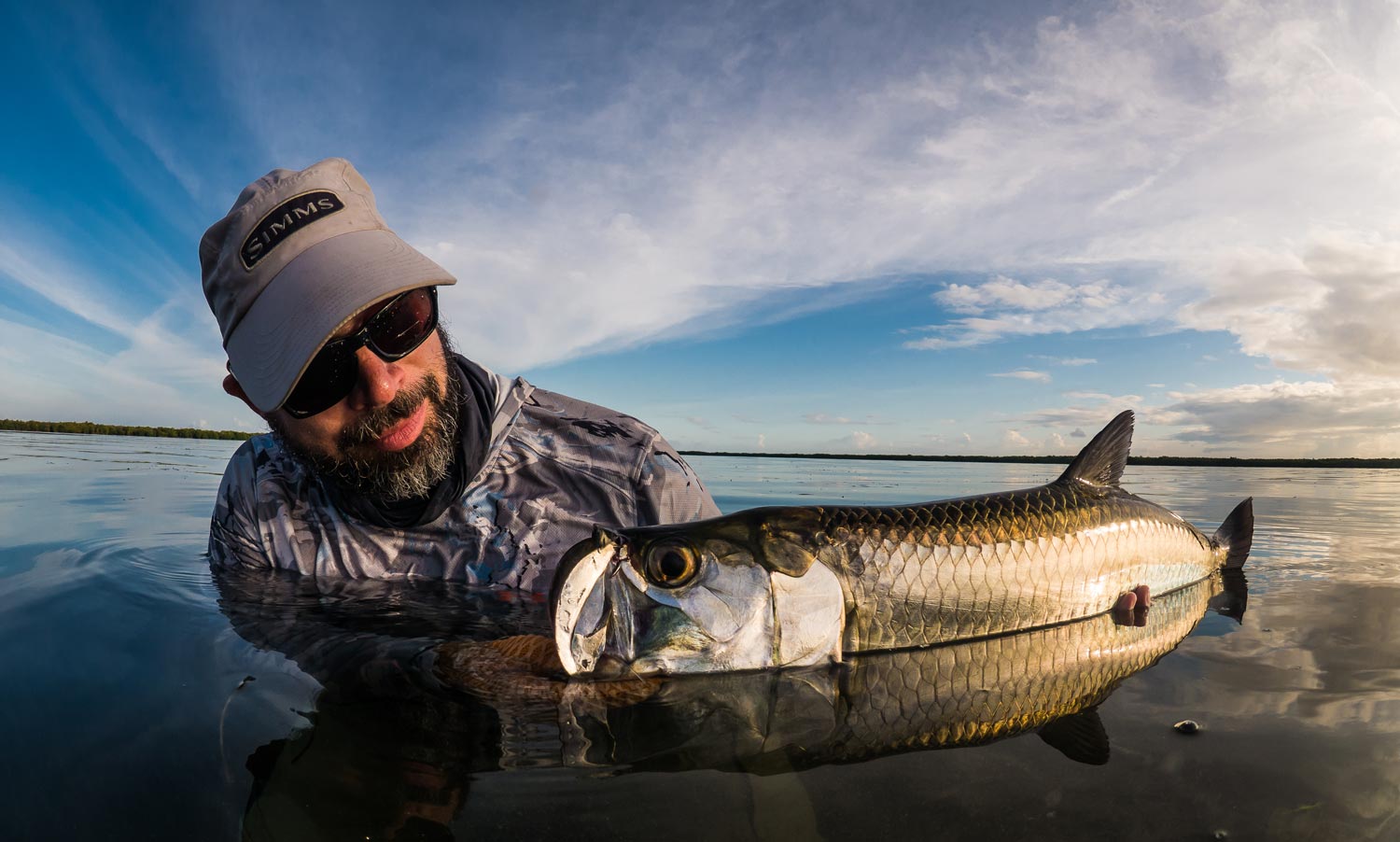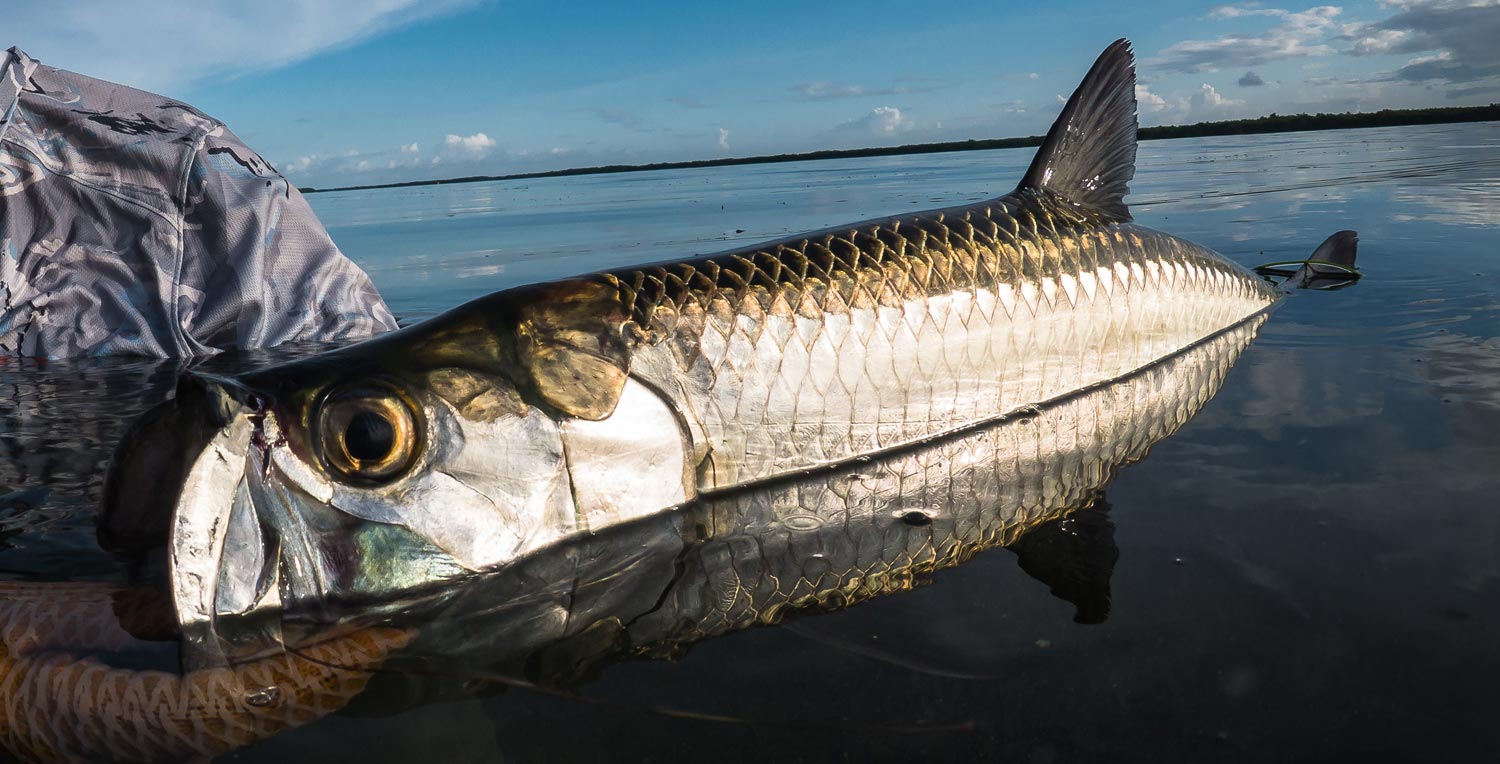By Louis Cahill
Tarpon are the king of Sport fish, even when they’re only ten pounds.
Standing on the bow of a flats boat at dawn, looking into a perfectly symmetrical sunrise reflecting on the glass-calm water, I can’t think of anywhere I’d rather be. When a pair of juvenile tarpon roll, they are so vivid that I’m momentarily surprised when their reflection does not appear in the sky. Rugged and chrome bright, they are perfect miniatures of their Goliath brethren. They may be only ten or twenty pounds but my heart beats just as quickly for them as it might for a world record fish.
When I first started tarpon fishing I had no interest in babies. I think that’s a common thing. I wanted to catch a ‘real tarpon’ and that meant a fish over a hundred pounds. Those monsters are truly amazing creatures. There’s no rush I know like hooking one. The moment when that first behemoth eats your fly and you bury the hook for all you’re worth and suddenly think,
“Oh shit! I’ve pissed it off. WTF am I going to do now?”
For years that was all of tarpon fishing to me, along with the brutal learning curve, the heartbreak of fickle conditions, the blistered hands and sore shoulders. Then my buddy Joel Dickey talked me into going out early one glass-calm morning to fish for baby tarpon. I had no idea how cool these little monsters are.
They are a total anomaly. On the one hand, they are tarpon in every way that matters. Stern and striking to look at. They catch more air than the Romanian gymnastic team. Their mouths are just as hard as the adults, making hook sets a privilege, not a right, and they fight like Hell’s Angels. I’ve broken 10 weights on them. They are tarpon to the bone.
On the other hand, they are completely different from those sulking bruisers you find migrating up the beach. They are aggressive. They like the fly stripped hard. They are competitive with each other, often racing to the fly. They move and hunt in packs like bonefish. They will sometimes explode violently on a fly dropped right on their nose. They are boney little badasses in every way and a blast to catch on a fly. There is a reason tarpon anglers say “baby tarpon” with a tone of reverence.
There are a couple of ways to target baby tarpon.
Early on calm mornings they can be found rolling in waist-deep water on turtle grass flats. Tarpon roll to gather oxygen, so it’s important that there is no wind to oxygenate the water and they will stop rolling when the sun is high enough that the turtle grass starts producing oxygen. It’s a narrow window but it happens with regularity in the Florida Keys during the summer.
Get on the flats at first light and pole slow and quiet, keeping an eye out for anything breaking the surface. You will not be able to see the fish in the water. Your only shot is to catch them rolling. When a fish rolls, put your fly about four feet in front of him as quickly as possible. The longer you take, the less certain you are of the fish’s location. Strip the fly with short, fast strips and be ready to strip set, even if the fish eats at the end of your strip.
If you do not hook the fish on this presentation, keep an eye out for bubbles rising to the surface. The tarpon will expel the air it’s taken in and these bubbles can give away its location. It may be traveling or milling around or just laying there so try to figure its behavior and make your best guess where to cast. Your highest percentage shot is one made quickly and accurately.
Once the sun is up, tarpon will roll much less frequently or not at all. As visibility becomes better, the fish will retreat to the cover of mangrove-lined shorelines. You will find them cruising in packs in shallow water, often right against the mangroves. Cast to the lead fish, leading him by four or five feet and crossing him by a couple of feet. Again, a fast short strip usually turns these fish on. Think like a fleeing shrimp.
These cruising fish can be really aggressive. The takes are often violent and the jump immediate and often when hooked. If they don’t respond to a lead and cross presentation, don’t be afraid to hit them on the head. Sometimes that will get an aggressive reaction from fish who have ignored your fly on previous attempts.
Flies for baby tarpon
Baby tarpon flies are a little different from what you might throw to adults. Smaller hobos, of course, are easier on the little guys and make getting a good hook set easier for the angler. Dawn patrol flies are usually either brightly colored or dark for better visibility in low light. For cruising fish later in the day, grass shrimp, pilchard patterns and other more natural flies work well.
Here’s a video of my buddy Bruce Chard tying his AM Express.
Don’t miss the chance to fish for these awesome sport fish on your next saltwater trip. Consider a dawn patrol session for a few hours in the morning, followed by a siesta and an afternoon / evening outing. You’ll be glad you gave the babies a try.
Look for my next article on baby tarpon soon where I’ll tell you about some unusual and very cool tarpon fishing.
Louis Cahill Gink & Gasoline www.ginkandgasoline.com hookups@ginkandgasoline.com Sign Up For Our Weekly Newsletter!



Tarpon are God’s gift to fly fishermen.
Terrific photo by Joel.
When is the G&G Tarpon trip?!
While catching them is fun, it is important to recognize they are vulnerable to fishing pressure too. I’ve seen baby tarpon spots with the same boat on it several days in a row. When hooked up, they are fun to jump a few times then shake off and let them go back to being babies.